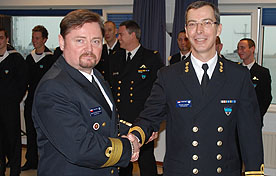Polish naval command makes NATO history
Making history is not something every commander can say when they hand over the rotational lead of one of NATO’s maritime groups. For Commander Krzysztof Jan Rybak, completing a year at the helm of NATO’s Standing Mine Countermeasures Maritime Group 1 (SNMCMG1), meant he was the first ever Pole to lead Alliance ships.

“I would compare the nomination to winning a championship and beating a world record at the same time,” says Cdr. Rybak who has been in the Polish navy some 25 years. “It was a great privilege to command the flagship vessel, the ORP Kontradmiral Xawer Czernicki, for that rotation.”
The Polish Navy initiated Poland’s involvement in NATO manoeuvres in 1993. Since then, as one of the newer members of NATO (1999), Poland has been participating in various NATO operations and training.
“Leading the group proved that even though Poland is the youngest member-country to take over – we were well prepared to lead multinational forces throughout 2010,” says Cdr. Rybak. “Back then we were writing a completely new page in the history of the Polish Navy, and I was starting a new chapter in my personal career.”
NATO has 4 standing maritime groups – Standing NATO Maritime Groups (SNMG) 1 and 2 and Standing NATO Mine Countermeasures Maritime Groups (SNMCMG) 1 and 2. Each is comprised of between three to five ships on rotational cycles. While ships in these groups are not always on active operation, they continue to conduct exercises all year round.
Offering a helping hand

“The main task of SNMCMG1 during all exercises and operations was to prepare safe lines of communication,” explained Cdr. Rybak. “The Polish navy has always used all possibilities to improve its abilities and to increase the level of training. Being well prepared is the main task for all the world’s navies.”
But it is not just pretend situations that the Cdr. Rybak found his group having to respond to. During a visit to another vessel during rough weather and choppy seas, SNMCMG1 received a may-day call from a ship in distress. The decision to help, along with the local Coast Guard, was made immediately. Disappointingly for Cdr. Rybak and his team however, the Coast Guard’s boats were nearer to vessel and dealt with the situation. “I was happy that everything ended without any casualities,” he says, “but I was disappointed that we had lost an occasion to provide expected help. It was however, a perfect test for us.”
Important role
Tales of rough seas and nights spent up on the bridge worrying over the smallest of the group’s units litter Cdr. Rybak’s recollections of his command, but they are all told with nostalgia.
“To be the Commander of SNMCMG1 means that you are one of the key players in the NATO command structure, and you are responsible for the NATO image,” he explains, adding that awareness of his role’s importance made the separation from his family easier. “It is a huge responsibility, and full of great satisfaction, but at the same time it means you have to be constantly ready for a change of situation.”
Although the command of SNMCMG1 was handed over to Dutch commander Herman W. Lammers in February of this year, the flagship vessel has remained Poland’s ORP Czernicki for this rotation.
The group has also been tasked following the recent unrest in Libya, to patrol the waters of the southern Mediterranean instead of disposing of historical ordnance around Italy. SNMCMG1 arrived in the area on March 18. Since the start of Operation Unified Protector, two of the group’s ships have been assigned to the operational command.
